Degi Mirch and Lal Mirch both add vibrant color and heat to Biryani, but Degi Mirch offers a deeper red hue with a moderate, smoky spice that enhances the dish's rich flavors without overpowering them. Lal Mirch, typically hotter and sharper, delivers an intense, fiery kick that can dominate the delicate balance of spices in Biryani. Choosing Degi Mirch is ideal for those seeking a visually appealing and well-rounded spice profile, while Lal Mirch suits those who prefer a bold, spicy punch in their meal.
Table of Comparison
| Spice | Type | Heat Level | Color | Flavor Profile | Best Use in Biryani |
|---|---|---|---|---|---|
| Degi Mirch | Red chili powder (mild to medium heat) | Medium | Deep red | Earthy, slightly smoky | Adds rich color and balanced heat without overpowering |
| Lal Mirch | Red chili powder (hot) | Hot | Bright red | Sharp, pungent, intense heat | Used for spicier biryanis needing strong heat impact |
Introduction to Degi Mirch and Lal Mirch in Biryani
Degi Mirch and Lal Mirch are essential spices that define the heat and color of biryani, with Degi Mirch offering a mild, vibrant red hue and a subtle smoky flavor ideal for balanced spice profiles. Lal Mirch, or red chili powder, delivers intense heat and a sharp, pungent taste, elevating the biryani's spiciness and depth. Choosing between Degi Mirch and Lal Mirch influences the biryani's aroma, flavor intensity, and visual appeal, making them crucial for achieving authentic taste variations.
Flavor Profiles: Degi Mirch vs Lal Mirch
Degi Mirch offers a deep, smoky flavor with moderate heat, enhancing biryani's rich and layered taste without overpowering other spices. Lal Mirch provides a sharper, more intense heat and a bright red color, adding a bold spiciness that intensifies the dish's overall flavor profile. Choosing between Degi Mirch and Lal Mirch influences the biryani's balance, where Degi Mirch emphasizes warmth and complexity, while Lal Mirch delivers a vibrant, fiery kick.
Color Impact: Enhancing Biryani Appearance
Degi Mirch imparts a deep red color to biryani, enriching its visual appeal with a warm, earthy hue that enhances the dish's traditional look. Lal Mirch, on the other hand, offers a brighter, vibrant red that intensifies the biryani's color but can sometimes appear artificial or overpowering. Choosing Degi Mirch over Lal Mirch elevates the biryani's presentation with a natural, appetizing color that complements the rich texture and aroma.
Heat Levels: Comparing Spiciness in Biryani
Degi Mirch offers a moderate heat level with a rich, smoky flavor ideal for enhancing biryani without overpowering other spices, making it suitable for balanced spice blends. Lal Mirch, on the other hand, provides a sharper, more intense heat that significantly raises the spiciness, ideal for those who prefer a fiery biryani experience. Selecting between Degi Mirch and Lal Mirch depends on the desired heat intensity and flavor profile, with Degi Mirch favoring subtle warmth and Lal Mirch delivering bold, high heat.
Aroma and Fragrance Differences
Degi Mirch imparts a rich, smoky aroma with subtle sweetness, enhancing biryani's depth and complexity, while Lal Mirch offers a sharper, more pungent fragrance that intensifies heat without overwhelming the dish. The fragrance profile of Degi Mirch complements the blend of spices typically used in biryani, adding warmth and a mild earthiness, whereas Lal Mirch stands out with its bright and penetrating scent. Choosing Degi Mirch results in a balanced aromatic experience, whereas Lal Mirch brings a bold and fiery note to the biryani spice mix.
Culinary Uses in Traditional Biryani Recipes
Degi Mirch offers a deep red color and a mild to medium heat, making it ideal for traditional biryani recipes that require vibrant appearance without overwhelming spiciness. Lal Mirch, known for its intense heat and bright red hue, is preferred in biryanis seeking a sharper chili kick and robust flavor profile. Using Degi Mirch balances aroma and spice, while Lal Mirch enhances the fiery heat essential in certain regional biryani variants.
Health Benefits: Degi Mirch vs Lal Mirch
Degi Mirch offers a milder heat with higher antioxidant content, making it beneficial for reducing inflammation and supporting heart health compared to Lal Mirch. Lal Mirch, with its intense spiciness, boosts metabolism and aids digestion due to capsaicin concentration but may irritate sensitive stomachs. Choosing Degi Mirch in biryani provides health benefits with balanced flavor, while Lal Mirch delivers a stronger kick alongside metabolism-boosting effects.
Availability and Regional Preferences
Degi Mirch, known for its vibrant color and moderate heat, is predominantly available in North Indian and Hyderabadi markets, making it a regional favorite for authentic biryani recipes. Lal Mirch, with a sharper and more intense spice profile, is widely accessible across India and preferred in regions like Maharashtra and Gujarat for a spicier biryani variant. The choice between Degi Mirch and Lal Mirch often hinges on local availability and traditional taste preferences, influencing the final flavor and heat intensity of the biryani.
Expert Tips for Balancing Spices in Biryani
Degi Mirch, known for its vibrant red color and moderate heat, enhances biryani with deep, smoky flavor without overpowering other spices, making it ideal for a balanced spice profile. Lal Mirch, or red chili powder, offers sharper pungency and intense heat, which requires careful moderation to avoid overshadowing aromatic notes like cardamom and cloves. Expert chefs recommend blending small quantities of both to achieve a harmonious balance, ensuring the biryani remains flavorful yet tender on the palate.
Which Mirch Should You Choose for Perfect Biryani?
Degi Mirch offers a mild heat with deep red color and smoky flavor, making it ideal for enhancing biryani's richness without overpowering other spices. Lal Mirch, on the other hand, provides a sharper, more intense heat and vibrant red hue, perfect for those seeking a spicier, more pungent biryani experience. Choosing between Degi Mirch and Lal Mirch depends on preferred heat level and flavor intensity to achieve the perfect balance in biryani.
Degi Mirch vs Lal Mirch for Biryani spice Infographic

 cookingyes.com
cookingyes.com